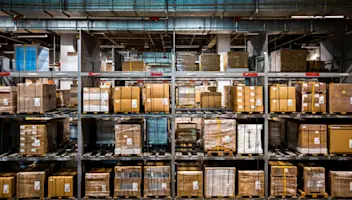The Two Extremes of Retail and Why Stock Visibility Is More Critical Than Ever
The Two Extremes of Retail and Why Stock Visibility Is More Critical Than Ever
The Two Extremes of Retail and Why Stock Visibility Is More Critical Than Ever
3 Apr 2020
David Sullivan
The rapid, global spread of the coronavirus has already brought many parts of the world to a standstill, confining consumers to their homes and disrupting business operations. And for retail operations around the world, it’s likely to get harder before it gets easier.
We’ve already seen the massive impact that COVID-19 has had on retail supply chains. According to CNBC, Chinese manufacturing is only just starting to come back online, while ISM research shows that three-quarters of US companies are feeling the strain of logistical challenges.
And while retailers globally are trying to thrive in an uncertain climate, we see the emergence of two extremes. Brands that fall into the ‘non-essential’ category have had to close stores, while ‘essential’ businesses – particularly Fast Moving Consumer Goods (FMCG) retailers – struggle to keep pace with overwhelming public demand.
In both these scenarios, the supply chain is facing disruption. Retailers need to manage inventory available stock carefully to weather the COVID-19 storm and come through it stronger than ever before.
Securing Every Sales Opportunity in a Supply Chain Crisis
The COVID-19 impact destabilizes retailers in two ways; it’s causing unpredictable changes in consumer buying behavior, and it’s also interrupting the manufacture, production and delivery of new stock according to usually scheduled deliveries.
We already see the perfect storm this is generating for the many FMCG brands currently struggling to keep pace with demand for virus-battling essentials such as sanitizing hand gel and toilet paper. Self-isolation leads to surges in demand for tertiary products such as DIY equipment, gardening products, cookware and children’s crafts.
Although retailers are beginning to adjust to the initial impact of this new world order, with Retail Week reporting that supermarket supply chains are easing, they are not out of the woods yet.
On the flip side, the critical challenge for other non-essential sectors is survival despite reduced sales channels. With the closure of retail stores, business has shifted online in most cases.
Still, there remains a lot of stress and uncertainty. When will the next batch of fresh stock become available? How severely will supply chain disruption affect short and medium-term operations? How can we provide safe working environments? Because of all of this, some retailers are closing their fulfillment centers. Next is one of the biggest brand names to take this decision.
Correlating Sales Data with Product Availability
To minimize the impact of current and future supply chain disruption, complete visibility of stock is critical. Retailers need to know precisely what they have available, in what volume, and where, to manage sales until operations return to normal. But gaining an accurate, real-time overview of stock is difficult to achieve in a multi-channel organization—unless companies are using sophisticated order management software to centralize operations.
Retailers need insight into the exact location of available stock across their business and how this correlates with product sales data. There is little point in having an abundance of one product in stores when bricks-and-mortar sales for that particular item are modest, but a limited supply available to meet online orders, which are much higher.
A Returning Issue
Retailers are also facing implications around returned items in the wake of the COVID-19 outbreak. With many stores having been closed, the returns process is has been mostly only available via shipping back to warehouses. As such, tracking and managing all these returns can be difficult without the right technology in place.
Multi-channel analytics software gives retailers up-to-the-minute business intelligence. Which means retailers can maximize sales in times of limited stock and bring returned goods back into the available stock pool as soon as the item has been appropriately processed—ensuring it’s allocated to the most appropriate channel.
Opportunity in the Face of Adversity
The impact of coronavirus on the global economy is already significant. The retail sector is being hit hard by isolation measures. But one silver lining of reducing public movement in a bid to slow the spread of COVID-19 is the increase in online sales.
When parts of China went into lockdown, cosmetics company Ling Qingxuan turned employees from stores closed down by the outbreak into online beauty advisors, communicating with customers virtually via channels like WeChat. This led to a 200% growth in year-on-year sales in the Wuhan area.
There is a separate argument over the morality of continuing to trade online at this time, and retailers have a duty of care to ensure workers can adhere to current health and safety and social distancing protocols. For those who keep their ecommerce operation up and running, there is an unexpected sales opportunity in the face of retail adversity.
Customers can only buy what’s there to sell, though. And the logistics associated with getting items packaged and sent out in times of supply chain disruption are not simple. Only retailers with the proper supporting infrastructure will be fit to fight the impact of COVID-19 on business operations.
In an Uncertain World, Stock Visibility Is Key
In truth, we don’t know how long-lasting the impact will be on the retail community even after the pandemic subsides, but we do know the value of an efficient business operation.
All we can do is manage the available information: both in terms of controlling the spread of the disease itself and ensuring that retailers have the resources available to keep trading where possible, safely and ethically.
Getting a complete overview of what stock can be sold right now is critical to maximizing sales opportunities in the wake of continued supply chain disruption and uncertainty. Retailers need the tools to reduce lost sales due to out-of-stocks in the short-term and minimize the backlog of orders waiting for them when we return to business as usual in the longer term—whenever that may be.
Are you ready to see how to gain complete stock visibility across your multi-channel operations and maintain an efficient retail experience? Aptean Retail ERP can help. Discover how, now.
Related Content


Ready to start transforming your business?
We’ve got the specialized ERP solutions you need to conquer your industry challenges.






